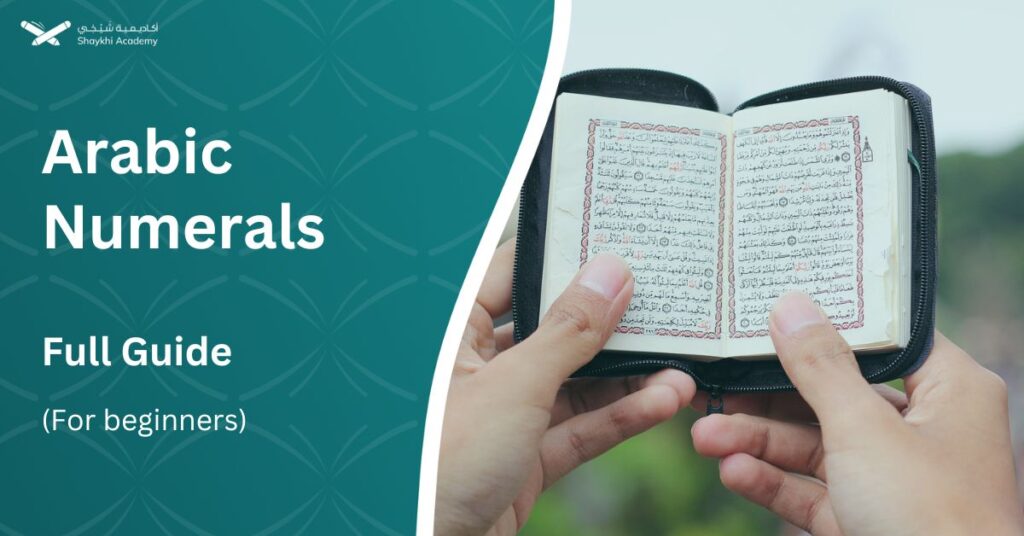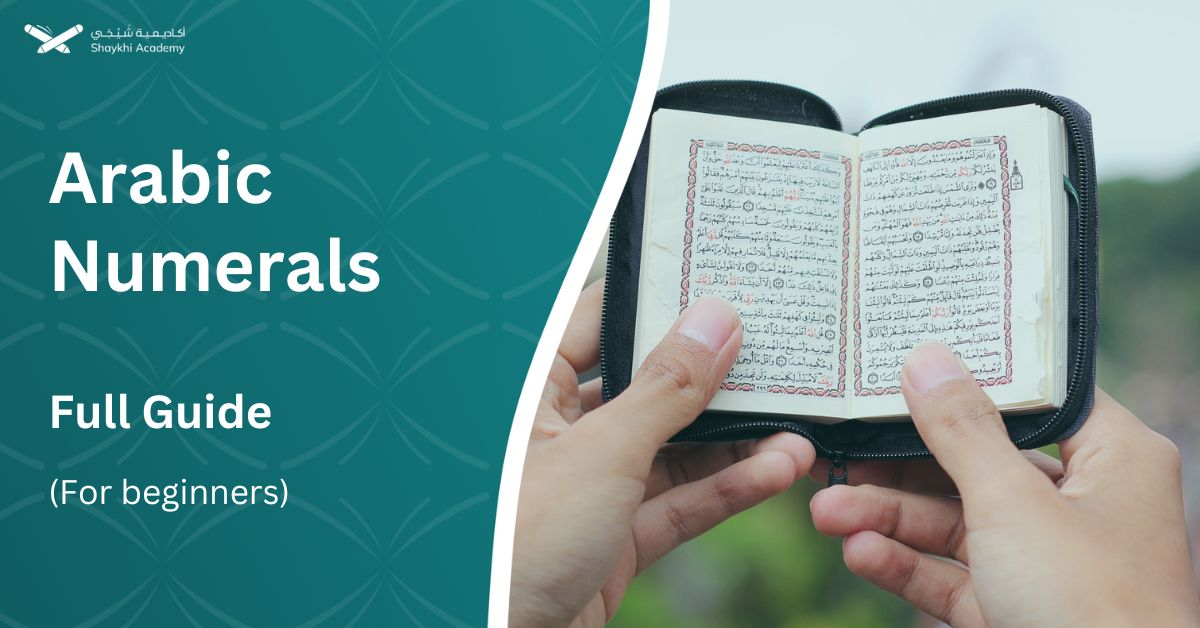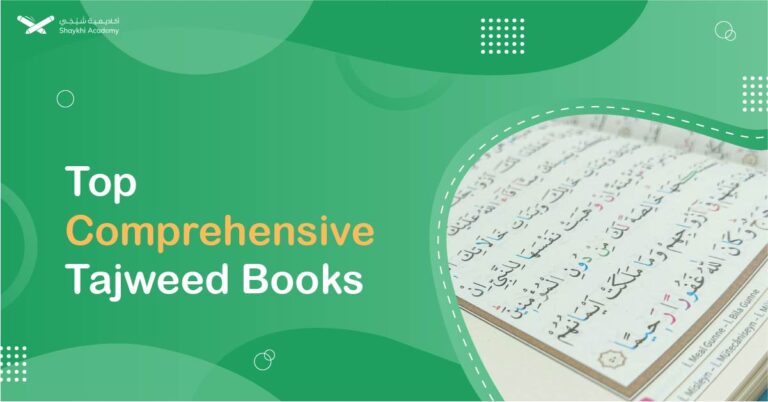While the study of Arabic language primarily revolves around its unique script and linguistic features, the importance of Arabic numerals in this context is noteworthy.
Arabic numerals have become an integral part of every trustworthy Arabic language course; such as the online Arabic course of Shaykhi Academy, due to their universal usage in mathematical and everyday contexts.

What Are the Arabic Numerals?
Arabic numerals, also known as Hindu-Arabic numerals, are the ten digits: 0, 1, 2, 3, 4, 5, 6, 7, 8, and 9, which form the basis of the decimal system widely used in modern mathematics and everyday arithmetic.
The adoption of Arabic numerals revolutionized mathematical notation and made complex calculations more accessible. Today, these numerals are universally employed in mathematics, science, and commerce, contributing to a standardized and efficient system of numerical representation globally.
First – One – واحد (Wahid):
The number 1, represented by the Arabic numeral “١,” holds a fundamental and singular position in the decimal numeral system. As the smallest and most basic numeral, it signifies unity and is the building block for all other Arabic numbers.
In addition to its quantitative value, the number 1 symbolizes the concept of singularity and individuality. Its simplicity belies its essential role in mathematical operations, serving as a multiplier and divisor in various calculations.
Second – Two – اثنين (Ithnayn):
The number 2, denoted by the Arabic numeral “٢,” is a fundamental digit in the decimal system. As the first and only even prime number among the Arabic numbers , 2 plays a unique role in mathematics.
It represents duality and pairs, forming the basis for even numbers. In addition to its mathematical significance, 2 holds cultural and symbolic importance, often representing balance, harmony, and opposites.
Third – Three – ثلاثة (Thalatha):
The numeral 3, depicted as “٣” in Arabic, is a pivotal digit in the decimal system, holding both mathematical and symbolic importance. Among the Arabic numbers, the initial odd prime number is 3, and it remains indivisible by any other whole number except 1 and itself, a crucial characteristic in number theory.
Beyond its mathematical relevance, the numeral 3 often carries cultural and symbolic weight, embodying notions of balance, harmony, and completeness. In numerous religious and mythological contexts, the number 3 is deemed sacred or meaningful.
Forth – Four – أربعة (Arb’aa):
The number 4, denoted by the Arabic numeral “٤,” is a fundamental digit in the decimal system with both mathematical and symbolic significance. As the smallest composite number, 4 is the product of multiplying two prime numbers (2 x 2). This characteristic makes it a crucial element in basic arithmetic and multiplication tables.
Beyond its mathematical role, the Arabic number 4 often holds cultural and symbolic importance, representing notions of stability, and order in various contexts. In many belief systems and traditions, the number 4 is associated with completeness and the four cardinal directions.
Fifth – Five – خمسة (Khamsa):
The number 5, represented by the Arabic numeral “٥,” is a key digit in the decimal system, carrying both numerical and symbolic significance. As the first prime number after 2, 5 is indivisible by any other whole number except 1 and itself, making it fundamental in number theory.
Beyond its mathematical importance, the Arabic number 5 often holds cultural and symbolic value; in many belief systems, the number 5 is associated with notions of protection, stability, and holistic completeness.
Sixth – Six – ستة (Setta):
The number 6 is expressed by the Arabic numeral “٦,” plays a crucial role in the decimal system, holding both mathematical and symbolic significance. As the product of multiplying the first two prime Arabic numbers (2 x 3), 6 is the smallest perfect number and has various divisors, making it versatile in mathematical operations.
Beyond its numerical properties, the number 6 often carries cultural and symbolic weight, symbolizing familial unity in different contexts. Moreover, in many traditions, the hexagon, which has six sides, is considered a symbol of balance and order.
Seventh – Seven – سبعة (Sab’aa):
The number 7, depicted by the Arabic numeral “٧,” holds special significance both mathematically and culturally. As a prime number, 7 is indivisible by any other whole number except 1 and itself, making it a key element in number theory.
Beyond its mathematical properties, the Arabic number 7 often carries symbolic weight, representing notions of completeness, spirituality, and good fortune in various cultural and religious contexts. In many traditions, the significance of the number 7 is evident in rituals, myths, and sacred texts.
Eighth – Eight – ثمانية (Thamanya):
The number 8, expressed by the Arabic numeral “٨,” plays a significant role in the decimal system, carrying both mathematical and symbolic importance. As the first cube of a natural number (2 x 2 x 2), 8 exhibits unique properties in mathematical operations and is often associated with concepts of symmetry and balance.
Beyond its mathematical significance, the number 8 holds cultural and symbolic weight, representing notions of prosperity, abundance, and infinity in various contexts. In some cultures, the figure-eight shape is considered a symbol of continuity and interconnectedness.
Ninth – Nine – تسعة (Tes’aa):
The number 9, is one of the Arabic numbers, represented by the Arabic numeral “٩,” is a pivotal digit in the decimal system, holding both mathematical and symbolic significance. As the highest single-digit number, 9 is often associated with completeness, finality, and wholeness. Its mathematical importance is evident as the product of multiplying the first three prime numbers (3 x 3), making it a square number.
Beyond its mathematical properties, the number 9 carries cultural and spiritual significance in various traditions, symbolizing spiritual growth and enlightenment. In some belief systems, 9 is considered a sacred and divine number, appearing in rituals, myths, and cosmic symbolism.
Where Did the Arabic Numerals Originate?
The origin of Arabic numerals can be traced back to the Indian subcontinent around the 6th century AD, marking the initial development of this numerical system.
The origin of Arabic numerals is a subject intertwined with cultural and historical exchanges, as the numerals were later transmitted to the Arab world through trade and intellectual collaborations.
The origin of Arabic numerals reflects their evolution and refinement in the Arab scholarly community, where mathematicians furthered their understanding and utilization.
The widespread adoption of Arabic numerals in various regions attests to the practicality and efficiency they offered. The origin of Arabic numerals, rooted in both Indian and Arab contributions, showcases the collaborative nature of human intellectual history.
Arabic Numerals vs Roman Numerals:
Arabic numerals and Roman numerals are two distinct numeral systems with contrasting features:
Arabic numerals, originating in the Indian subcontinent, include the digits 0 to 9 and form the basis of the decimal system. They offer a place-value system, allowing for efficient and straightforward representation of numbers, making complex calculations more accessible. Arabic numerals have become the standard in modern mathematics, science, and everyday life due to their simplicity and efficiency
In contrast, Roman numerals, derived from ancient Rome, employ a combination of letters such as I, V, X, L, C, D, and M to represent values. Roman numerals lack a zero and a true place-value system, which can make arithmetic operations cumbersome and less intuitive. Roman numerals are predominantly used in specific contexts such as clock faces, book chapters, and formal enumerations, showcasing the distinct applications of each numeral system.
Differentiate it with the Arabic alphabet in numbers.
Why Did Arabic Numerals Replace Roman Numerals?
Arabic numerals gradually replaced Roman numerals for several practical reasons that contributed to their widespread adoption:
1- Efficiency and Simplicity:
Arabic numerals offered a more efficient and simpler representation of numbers compared to Roman numerals. The place-value system of Arabic numbers facilitated straightforward arithmetic operations, making calculations easier and more intuitive.
2- Place-Value System:
The place-value system employed by Arabic numerals allowed for a clearer representation of numbers by assigning values based on the position of digits. This innovation significantly improved the efficiency of mathematical expressions, enabling more complex calculations.
3- Inclusion of Zero:
Arabic numbers included the digit zero, a concept absent in Roman numerals. The introduction of zero and its incorporation into positional notation enhanced the versatility of the numeral system, allowing for the development of advanced mathematical concepts, particularly in algebra.
4- Global Acceptance in Trade and Commerce:
As trade and commerce expanded globally, the practical advantages of Arabic numerals became apparent. Merchants, mathematicians, and scientists found the Arabic numeral system to be more adaptable and user-friendly, contributing to its widespread acceptance and use in various cultures.
5- Advancements in Mathematics:
The adoption of Arabic numerals marked a significant advancement in mathematical notation. The system’s adaptability and efficiency facilitated the development of more sophisticated mathematical concepts, contributing to the evolution of mathematics beyond basic arithmetic.
Unlock the world of Arabic numerals with our immersive Arabic language course!
Join our online Arabic classes now and gain proficiency in both the linguistic beauty of Arabic and the practical application of Arabic numbers.
Our around-the-clock classes ensure flexibility for learners worldwide.
From mastering the Arabic script to confidently navigating numerical expressions, our expert instructors guide you every step of the way. Don’t miss the chance to enhance your language skills and numerical fluency simultaneously!
Enroll today and embark on a journey to linguistic and numerical excellence.
Understanding and utilizing Arabic numerals is essential for Arabic speakers in various practical situations, including financial transactions, dates, and numerical expressions.




















